The Bitruncated 24-cell
The Bitruncated 24-cell is a uniform polychoron bounded by 48 truncated cubes, with 336 polygons (192 triangles, 144 octagons), 576 edges, and 288 vertices. It is both vertex-transitive and cell-transitive. It can be obtained by truncating the 24-cell at a depth halfway to obtaining the dual 24-cell.
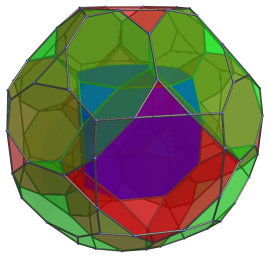
It is also known as “octagonny” (due to Wendy Krieger) because of its connection with octagonal numbers (Z4).
Structure
The following cell-first parallel projection of the bitruncated 24-cell shows the nearest cell to the 4D viewpoint.
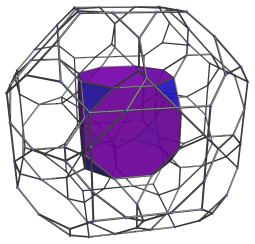
The octagonal faces of this cell are joined to 6 other cells, shown in the following image:
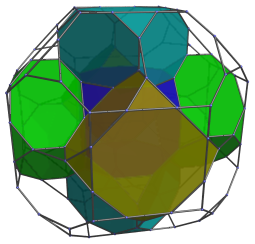
These cells are arranged in a cubical arrangement.
The triangular faces of the nearest cell are joined to 8 other cells. The following image shows 8 cells surrounding the nearest cell.
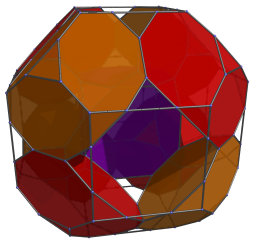
These cells are arranged in an octahedral arrangement.
The 15 cells we've seen so far lie on the “northern hemisphere” of the bitruncated 24-cell. The next image shows 6 of the 18 cells that lie on the “equator”.
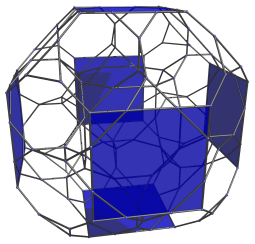
These equatorial cells appear to be flat squares because they lie at a 90° angle to the 4D viewpoint. In reality, they are perfectly uniform truncated cubes.
Together with the “north pole” and “south pole” cells, these cells correspond with the 8 cells of a tesseract that the bitruncated 24-cell can be inscribed into. The next image shows these cells (minus the “south pole” cell, which lies behind the central cell in the fourth direction and is obscured from view here.
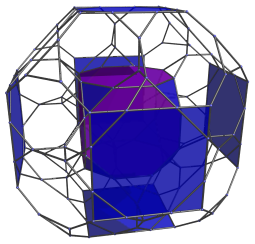
The next image shows the other 12 equatorial cells. These correspond with the 12 edges of a cube, or the faces of a rhombic dodecahedron.
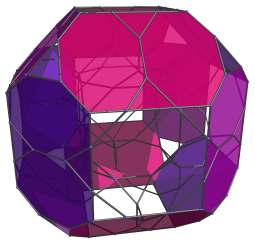
Again, these cells also appear to be flat because they also lie at a 90° angle to the 4D viewpoint. In 4D, they are perfectly uniform truncated cubes.
After these cells, we have the “southern hemisphere” cells, which mirror the arrangement of the northern hemisphere cells. Hence, we have a total of 1+6+8=15 northern hemisphere cells, 15 southern hemisphere cells, and 6+12=18 equatorial cells, for a total of 48 cells.
Perspective Projections
The following image shows a perspective projection of the bitruncated 24-cell.

The nearest cell is rendered in blue, the cells sharing an octagonal face with it in red, and the cells sharing a triangular face with it in green. The equatorial cells are not visible because they make an angle larger than 90° with the viewpoint.
Coordinates
The coordinates of the vertices of the bitruncated 24-cell are all permutations of coordinates and changes of sign of:
- (0, 2+√2, 2+√2, 2+2√2)
- (1, 1+√2, 1+√2, 3+2√2)
Properties
The bitruncated 24-cell is one of the two non-prismatic, non-regular uniform polychora that are both cell-transitive and vertex-transitive. The regular polychora have this property, as well as the bitruncated 5-cell and the n,n-duoprisms.




